The NVIDIA GeForce GTX 1080 Preview: A Look at What's to Come
by Ryan Smith on May 17, 2016 9:00 AM ESTGaming Performance, Power, Temperature, & Noise
So with the basics of the architecture and core configuration behind us, let’s dive into some numbers.
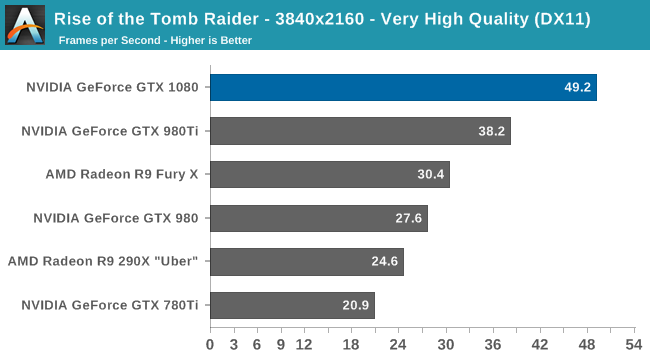

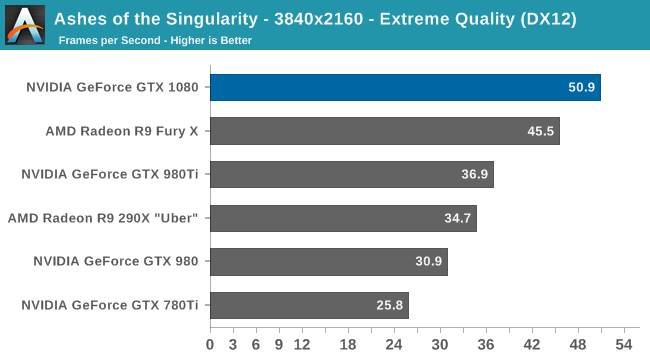

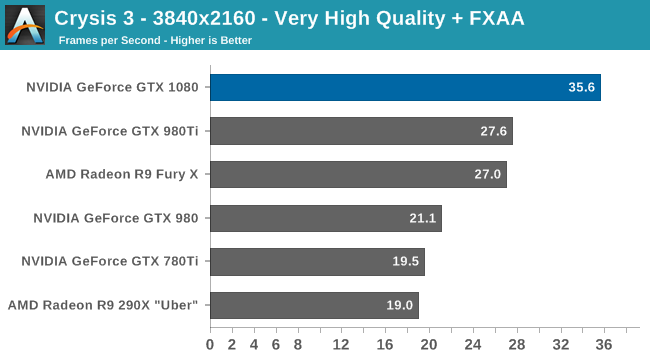
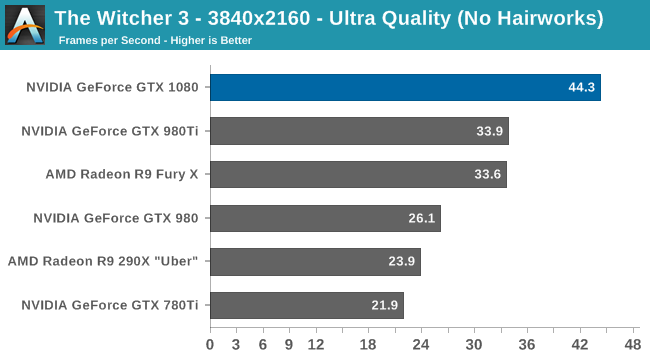
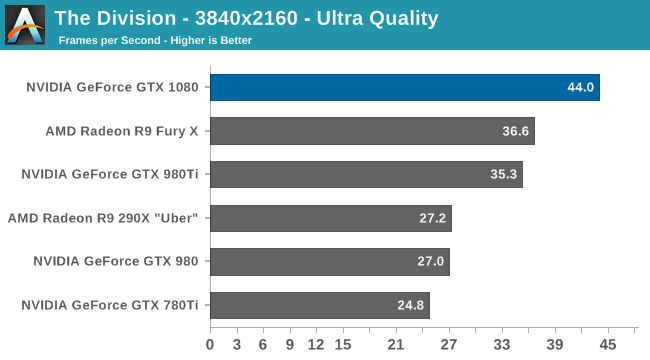
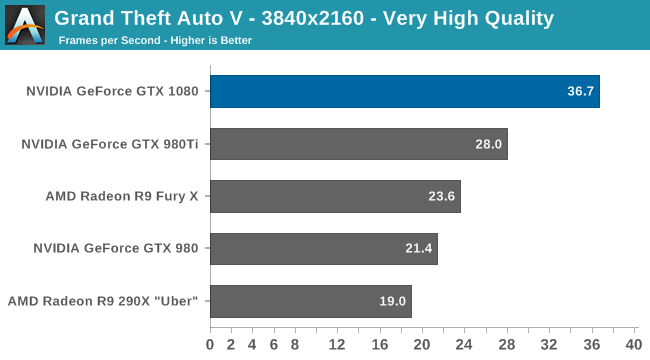
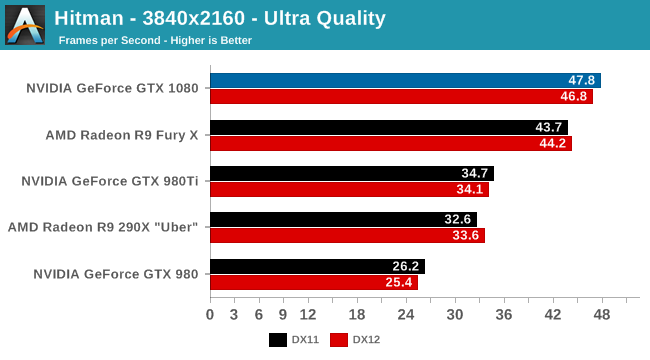
As the first high-end card of this generation to launch, NVIDIA gets to set the pace for the market. At the risk of being redundant the GTX 1080 is now the fastest single-GPU card on the market, and even at 4K it wins at every single gaming benchmark, typically by a good margin. In practice we’re looking at a 31% performance lead over GTX 980 Ti – the card the GTX 1080 essentially replaces – with a similar 32% lead over AMD’s Radeon R9 Fury X. Meanwhile against the slightly older GTX 980, that gap is 70%.
On a generational basis this ends up being very close to the 74% jump in 4K performance going from the GTX 680 to GTX 980. And although the pricing comparison is not especially flattering for NVIDIA here, it should be evident that NVIDIA isn’t just looking to sell GTX 1080 as an upgrade for high-end Kepler cards, but as an upgrade for GTX 980 as well, just 20 months after it launched.
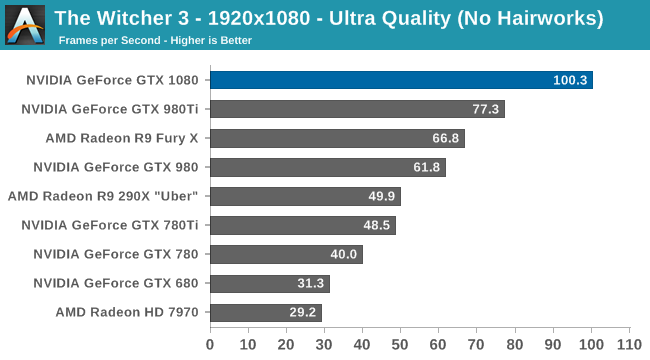
I also wanted to quickly throw in a 1080p chart, both for the interest of comparing the GTX 1080 to the first-generation 28nm cards, and for gamers who are playing on high refresh rate 1080p monitors. Though this will of course vary from game to game, roughly speaking the GTX 1080 should be 3x faster than the GTX 680 or Radeon HD 7970. This is a good reminder of how architectural efficiency has played a greater role in past years, as this is a much larger gain than we saw jumping from 55nm to 40nm or 40nm to 28nm, both of which were much closer to the historical norm of 2x.

Meanwhile when it comes to power, temperature, and noise, NVIDIA continues to execute very well here. Power consumption under Crysis 3 is some 20W higher than GTX 980 or 52W lower than GTX 980 Ti, generally in line with NVIDIA’s own TDP ratings after accounting for the slightly higher CPU power consumption incurred by the card’s higher performance. The end result is that GTX 1080 is a bit more power hungry than GTX 980, but still in the sweet spot NVIDIA has carved out in the gaming market. Broadly speaking, this amounts to a 54% increase in energy efficiency in the case of Crysis 3.
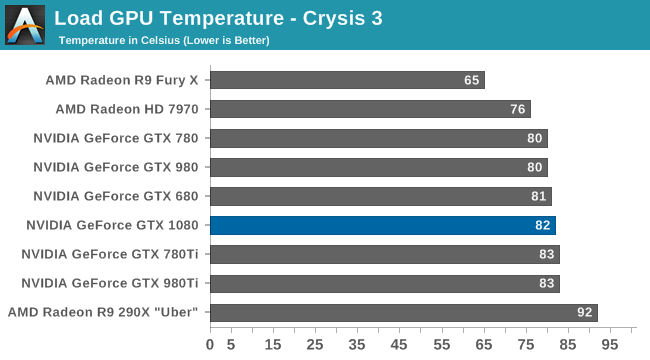
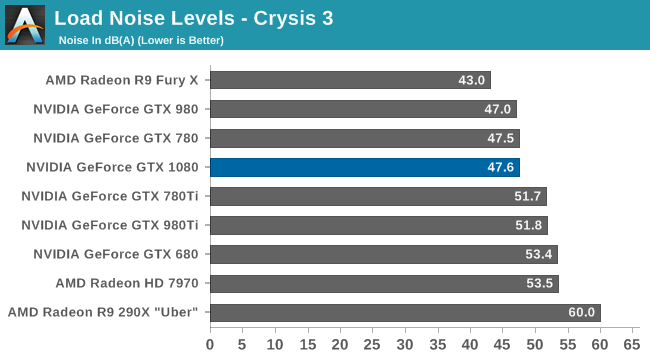
Otherwise from a design perspective the GTX 1080 Founders Edition carries on from NVIDIA’s high-end GTX 700/900 reference design, allowing NVIDIA to once again offer a superior blower-based solution. NVIDIA’s temperature management technology has not changed relative to Maxwell, so like their other cards, the GTX 1080 tops out in the low 80s for load temperature. More significantly, at 47.5 db(A) load noise, the card is on par with the GTX 780 and half a dB off of the GTX 980.
Ultimately NVIDIA has designed the GTX 1080 to be a drop-in replacement for the GTX 980, and this data confirms just that, indicating that GTX 1080’s much higher performance comes with only a slight increase in power consumption and no meaningful change in temperatures or acoustics.


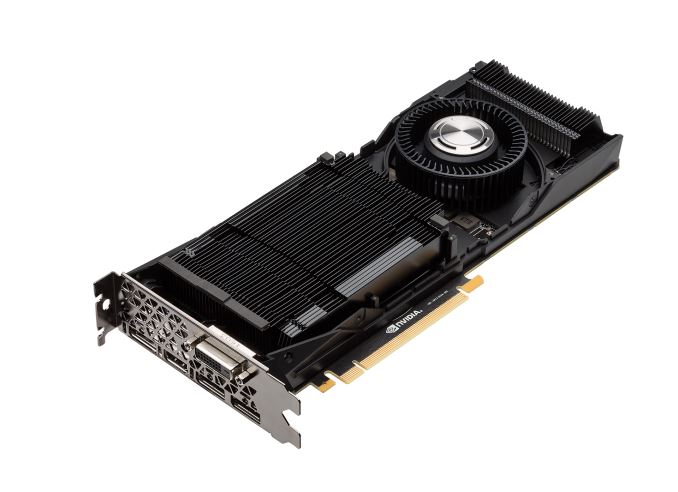








262 Comments
View All Comments
Ryan Smith - Tuesday, May 17, 2016 - link
I can already tell you right now that at an architectural level, per-clock per-core performance between GP104 and GM204 is virtually identical. Throughput of the ALUs, texture units, ROPs, etc has not changed. What makes GP104 faster than GM204 is the larger number of SMs, the higher clockspeeds, and a memory subsystem fast enough to feed the former.(Which is not to discount the Pascal architecture. 16nm FinFET alone won't let you ramp up the clockspeeds like this. NVIDIA had to specifically engineer the architecture to hit those clockspeeds without driving up the power consumption)
modeless - Tuesday, May 17, 2016 - link
There's only one thing I want to know about this card. Does it support the special instructions that the Tesla P100 has for half precision float (FP16), which double throughput? This is very important for deep learning and nobody has confirmed yet.vladx - Tuesday, May 17, 2016 - link
It most surely doesn't support those like P100 as that is the whole point of selling Tesla at such high price.dragonsqrrl - Tuesday, May 17, 2016 - link
So has that been confirmed by Nvidia or a review, or is that your assumption?vladx - Tuesday, May 17, 2016 - link
I'm 100% sure since GTX 1080 which is based on GP104 has a different architecture than P100 and almost identical to Maxwell.Yojimbo - Wednesday, May 18, 2016 - link
I'm 100% sure you're wrong, because the GP106, or something like it, will be used in the Drive PX 2 and will have double throughput half precision support since it's going to be used as a machine learning inference engine. If the GTX 1080 doesn't support double throughput half-precision support it's probably because they purposefully disabled it to prevent the cards from being used in high quantities for compute workloads. They will probably, at some point, come out with a Tesla based on the GP104 and/or the GP106 that does support double throughput half-precision compute, to replace the M40 and M4 cards. Pascal does everything better than Maxwell so it would be starving a growing industry to leave that segment to Maxwell for too long.vladx - Wednesday, May 18, 2016 - link
Huh? We know next to nothing about GP106 architecture unlike with GP100 and GP104 chips which like I said have different architectures with GP104 (GTX 1080) being almost identical to Maxwell on a hardware level.vladx - Wednesday, May 18, 2016 - link
Anyways, see Ryan Smith's answer below. I was 100% correct.dragonsqrrl - Wednesday, May 18, 2016 - link
Not necessarily. In fact I would be very surprised if GP104 doesn't support the double FP16 throughput. Like yojimbo said, the more likely scenario is that half precision performance is capped in some way on GeForce cards (likely through firmware).vladx - Thursday, May 19, 2016 - link
When we're talking about an architecture, we're speaking about an instrustion set. Since GP104 lacks certain compute instructions compared to GP100 in P100 then we can accurately say they have different architectures. Yes they are both Pascal and they have the same featurees on software-level but hardware-wise they are different. Doesn't matter how Nvidia enforces those differences, what matters is that they're different at an architecture-level(instruction set).